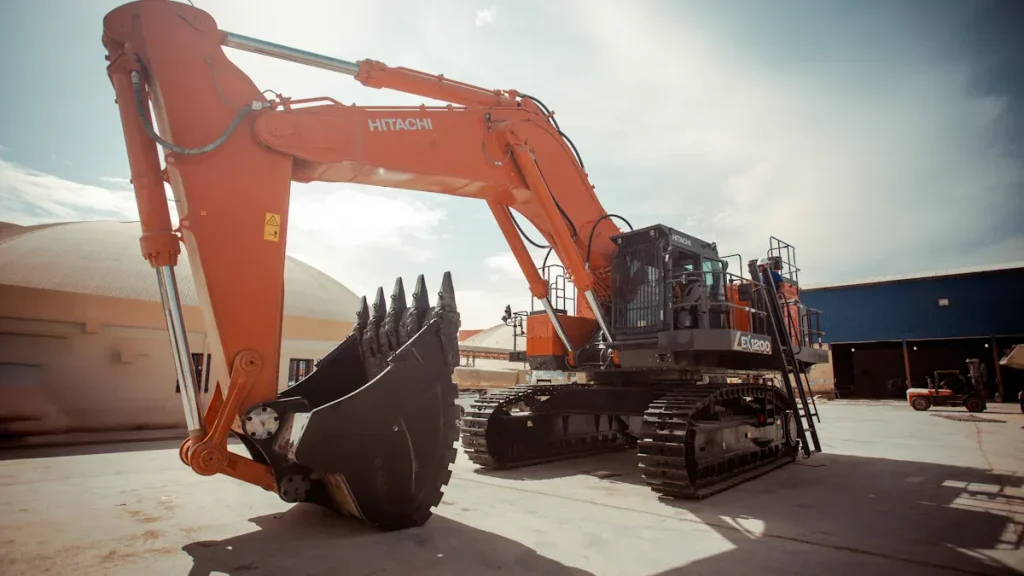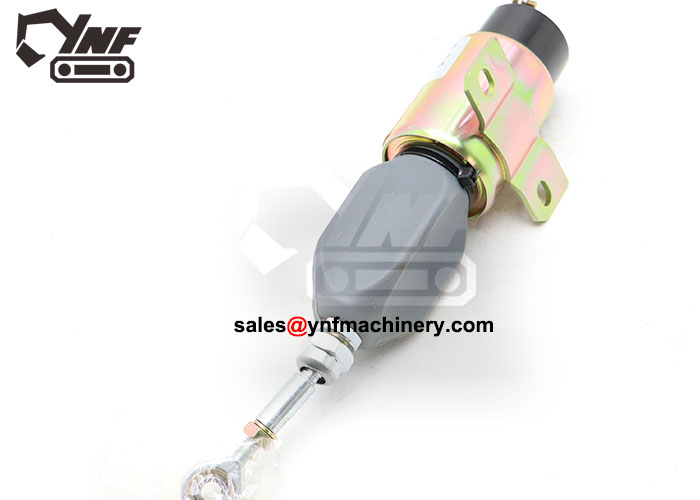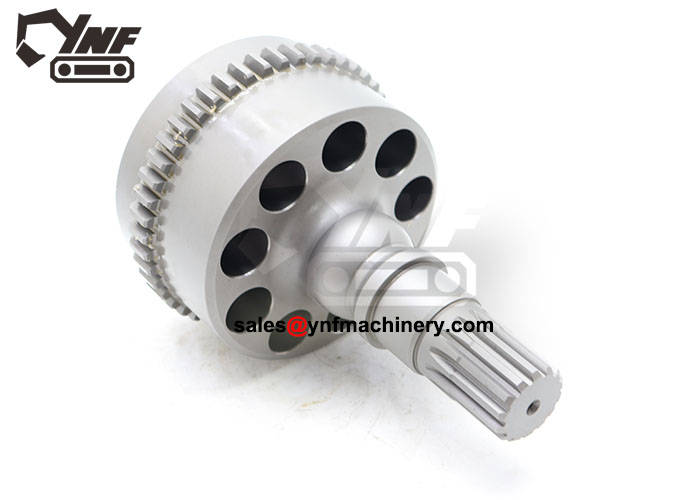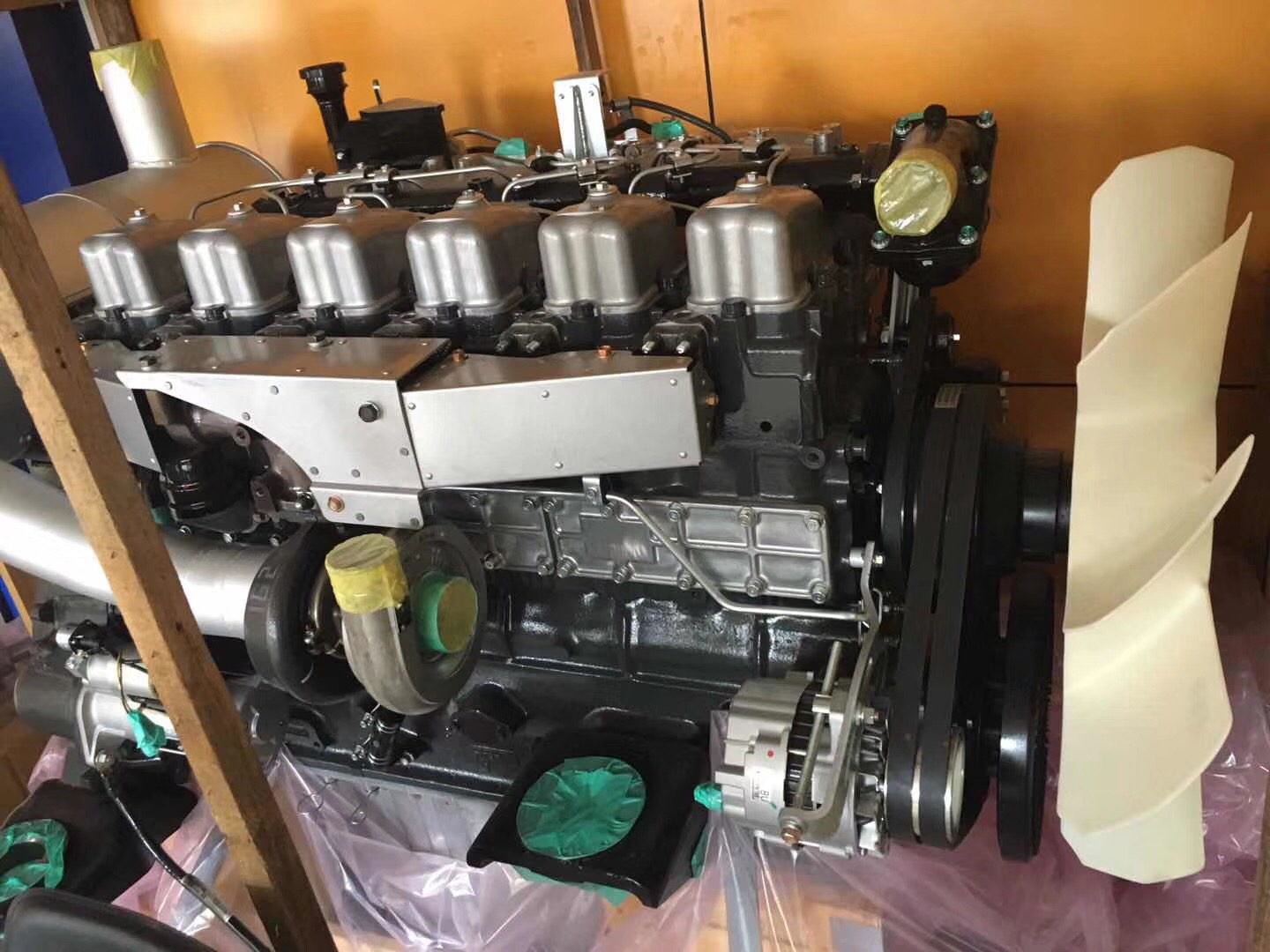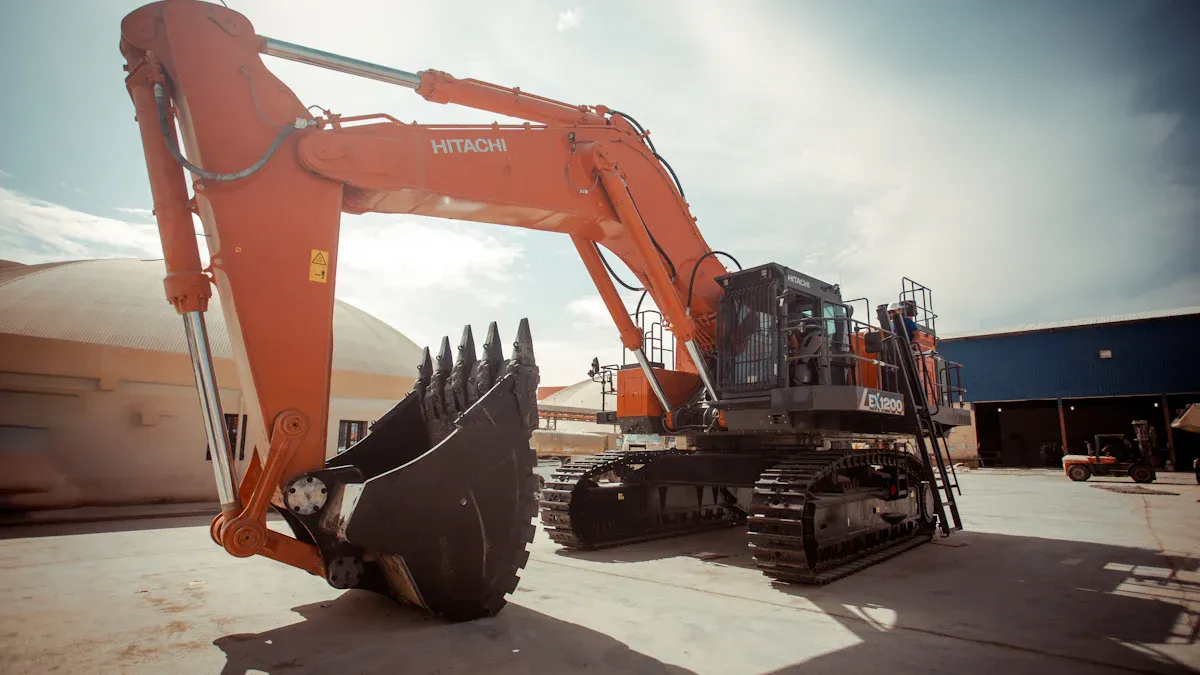
Understanding how excavator body parts function is crucial. Each component, such as the boom and cab, contributes to the machine’s overall performance. The boom and arm are essential for digging and lifting tasks, while the cab provides the operator with clear visibility and control. Regularly inspecting parts like drive sprockets and top rollers can prevent damage and enhance the machine’s longevity. YNF Machinery offers a valuable guide on quality excavator body parts, ensuring your excavator remains robust and operates efficiently.
Key Takeaways
Knowing excavator parts, like the boom and bucket, helps in using and fixing them well.
Checking important parts, like the hydraulic system and undercarriage, often can stop big repairs and make the machine last longer.
Picking the right bucket for each job makes work faster and keeps the excavator safe.
Training operators properly is important for safe and good use, lowering the chance of accidents.
Using good parts from trusted sellers, like YNF Machinery, makes the machine work better and break down less.
Overview of Excavator Body Parts
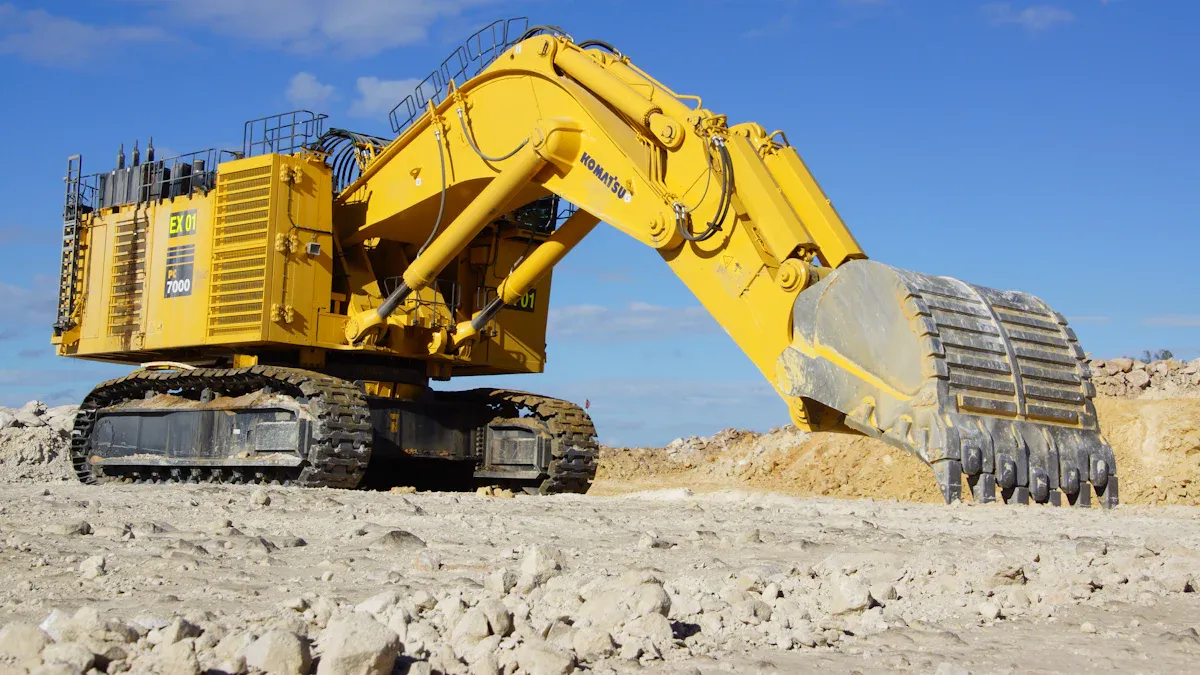
Boom and Stick
The boom and stick are key parts of an excavator. These two parts help the machine dig and lift. The boom is the bigger arm that connects to the main body. It stretches outward to do its job. The stick, which is attached to the boom, adds extra reach and accuracy. Together, they help the machine dig trenches, lift heavy items, and reach hard spots. These parts are built to handle heavy loads. They are usually made from strong steel to last a long time.
Bucket
The bucket is one of the easiest parts to spot. It is fixed at the end of the stick and is used for digging and moving materials. Buckets come in different shapes and sizes for various jobs. Some are for general digging, while others are for trenching, grading, or breaking rocks. The teeth on the bucket help it cut through tough dirt, clay, or rock. Checking and fixing the bucket often is important. This keeps it working well and prevents damage.
Cab
The cab is where the operator controls the excavator. It has all the tools needed to run the machine. Modern cabs are made to be safe and comfortable. They have comfy seats, air conditioning, and easy-to-use controls to reduce tiredness. The cab gives a clear view, helping the operator work safely and quickly. Some cabs have strong glass and protective parts to keep the operator safe from flying debris. This makes the cab one of the most important parts for safe and smooth operation.
Tip: Taking care of the boom, stick, and bucket regularly can make your excavator last longer and work better.
Hydraulic System
The hydraulic system is very important for an excavator. It moves the boom, stick, bucket, and other main parts. This system uses pressurized fluid to create energy. This energy helps the machine work with power and accuracy. Newer excavators have advanced systems like D-ECOPOWER+ to save fuel and work better.
Hydraulic Flow (l/min) | System Pressure (bar) | Technology |
|---|---|---|
1008 | 343 | D-ECOPOWER+ |
Taking care of the hydraulic system is very important. Check hoses, seals, and cylinders for leaks or damage. Replace worn-out seal kits to keep it running smoothly. This also avoids expensive repairs. YNF Machinery sells strong seal kits that work well in tough conditions.
Tip: Always keep hydraulic fluid clean and at the right level. This helps your excavator work better and last longer.
Undercarriage
The undercarriage is the base of the excavator. It keeps the machine steady and helps it move. It has tracks, sprockets, rollers, and a frame. Tracks made of strong steel or rubber help the machine move on mud, gravel, or rocks. Some excavators have wheels, but tracks are better for uneven ground.
Tracks help the excavator move on rough surfaces.
The undercarriage holds the machine’s weight and handles stress.
Keeping the undercarriage in good shape is very important.
Check the undercarriage often to avoid big repairs. Clean the tracks and look for damage to improve performance. YNF Machinery offers strong parts for the undercarriage. These parts meet high standards and work well in tough jobs.
Engine
The engine is the most important part of an excavator. It gives power to the hydraulic system and other parts. Most excavators use diesel engines because they are strong and efficient. YNF Machinery sells many engine parts like pistons, cylinders, and turbochargers. These parts are made to handle tough conditions and work well.
Taking care of the engine is very important. Change the oil, clean air filters, and check fuel injectors often. Using good-quality parts lowers fuel use and pollution. This also saves money. YNF Machinery has both OEM and aftermarket parts for flexibility.
Note: A well-cared-for engine works better and lasts longer.
Counterweight
The counterweight is an important part of an excavator. It is found at the back of the machine. Its job is to balance the boom, stick, and bucket. Without it, the excavator could tip over. This is especially true when lifting heavy things or stretching the arm far. The counterweight keeps the machine steady, even on bumpy ground.
Manufacturers make counterweights from heavy materials like steel or cast iron. This makes them strong without being too bulky. Some excavators let you adjust or remove the counterweight for easier transport. Check the counterweight often for cracks or damage. A broken counterweight can make the machine unsafe to use.
Tip: Always check that the counterweight is tightly attached before working. This simple check can stop accidents and keep the job site safe.
Tracks or Wheels
Tracks or wheels help the excavator move around. Tracks, made of rubber or steel, work well on rough ground. They spread the machine’s weight evenly. This stops the excavator from sinking into soft dirt. Wheels are better for flat, hard surfaces. They also let the machine move faster between work areas.
Clean and check tracks often to remove dirt or rocks. Rubber tracks are quieter and protect paved roads. Steel tracks last longer and handle tough jobs. If your excavator has wheels, check the tires for wear. Keep them filled with the right amount of air for smooth movement.
Note: Pick tracks or wheels based on your work area. Tracks give better balance, while wheels are faster and easier to steer.
Control System
The control system is like the brain of the excavator. It helps you operate all the machine’s parts. New systems use smart technology to work better and save fuel. For example, the DX800LC-7 excavator has a hydraulic flow of 1008 l/min. It also works at a pressure of 343 bar. With D-ECOPOWER+ technology, the system controls the pump electronically. This boosts fuel efficiency and work output.
The control system lets you dig, lift, and grade easily. It includes joysticks, pedals, and screens for full control. Keep the control system in good shape by checking and adjusting it regularly.
Tip: Learn how to use the control system features. This can save fuel and make your work more accurate.
Functions of Important Parts of Excavators
Boom and Stick: Lifting and extending reach
The boom and stick are key parts of an excavator. These parts work together to help the machine dig and lift. The boom is the main arm that stretches out from the excavator’s body. It reaches the work area to perform tasks. The stick, connected to the boom, adds extra reach and accuracy. Together, they let you dig trenches, lift heavy items, and reach tricky spots easily.
These parts are strong and built for tough jobs. Regularly check them for cracks or wear to keep them working well. Taking care of these parts helps the excavator stay reliable and avoids expensive repairs.
Tip: Always check the boom and stick for damage before using the machine. Fixing problems early can save time and money.
Bucket: Digging and material handling
The bucket is one of the most noticeable parts of an excavator. It is used for digging, scooping, and moving materials like dirt, gravel, or rocks. Buckets come in different shapes and sizes for specific jobs. For example, trenching buckets are narrow for digging small trenches, while grading buckets are wide for leveling surfaces.
The teeth on the bucket help it cut through hard materials. Check the bucket often for wear and replace broken teeth when needed. A well-kept bucket works smoothly and prevents delays during work.
Note: Picking the right bucket for your job can make work faster and protect the machine from damage.
Cab: Operator’s control center
The cab is where the operator controls the excavator. It has all the tools needed to run the machine. Modern cabs are made to be safe and comfortable. Features like comfy seats, air conditioning, and easy-to-use controls help reduce tiredness during long hours.
The cab also gives a clear view, making work safer and more accurate. Some cabs have strong glass and protective parts to keep the operator safe from flying debris. Keeping the cab clean and ensuring controls work properly is important for safety and efficiency.
Tip: Learn how to use the cab’s controls and features. This helps you work better and stay safe.
Hydraulic System: Powering movement and functionality.
The hydraulic system is very important for an excavator. It moves the boom, stick, and bucket to do tasks. This system uses pressurized fluid to create force for digging and lifting. Without it, the machine cannot do its main jobs.
Check the hydraulic system often to keep it working well. Look for leaks in hoses, seals, and cylinders. Replace worn parts quickly to avoid big repairs. Using strong seal kits, like those from YNF Machinery, helps prevent problems and keeps the system efficient.
Tip: Always use clean hydraulic fluid and keep it at the right level. Dirty fluid can harm the system and lower its performance.
Undercarriage: Stability and mobility.
The undercarriage is the base of the excavator. It holds the machine steady and supports its weight. It includes tracks, rollers, sprockets, and a frame. Tracks, made of steel or rubber, help the machine move on mud, gravel, or rocks.
Clean the undercarriage after every use to avoid damage. Dirt and rocks can get stuck in the tracks and cause wear. Check the rollers and sprockets for cracks or breaks. Fixing these parts on time keeps the machine stable and easy to move.
Note: Taking care of the undercarriage makes the excavator last longer and work better.
Engine: Powering the excavator (featuring YNF Machinery’s Excavator Engine Parts).
The engine is the most important part of an excavator. It gives power to the hydraulic system and other parts. Most excavators use diesel engines because they are strong and work well. YNF Machinery sells many engine parts like pistons, cylinders, and turbochargers that handle tough jobs.
Take care of the engine to keep it running smoothly. Change the oil, clean air filters, and check fuel injectors often. Using good parts from YNF Machinery saves fuel and lowers pollution, which also saves money.
Tip: A well-cared-for engine works better, lasts longer, and avoids delays in your projects.
Counterweight: Keeping the machine steady.
The counterweight helps keep the excavator balanced while working. It is located at the back of the machine. Its job is to balance the boom, stick, and bucket when lifting or digging. Without it, the excavator might tip over, especially with heavy loads or when the arm is fully stretched.
Manufacturers make counterweights from heavy materials like steel or cast iron. This gives balance without making the machine too bulky. Some excavators have counterweights that can be removed or adjusted. This makes moving and storing the machine easier. Check the counterweight often for cracks or loose parts. A damaged counterweight can make the machine unsafe to use.
Tip: Always check the counterweight before starting work. This keeps the machine safe and prevents accidents.
Tracks or Wheels: Moving on different surfaces.
Tracks or wheels help the excavator move on various surfaces. Tracks, made of rubber or steel, spread the machine’s weight evenly. This stops it from sinking into soft ground. They work well on mud, gravel, or rocky areas. Wheels are better for flat, hard surfaces and let the machine move faster between sites.
Take care of these parts to keep them working well. Clean tracks to remove dirt and rocks that can cause damage. Check rollers and sprockets for cracks or wear. For wheeled excavators, check tire pressure and tread often. Proper care makes these parts last longer and work better.
Note: Use tracks for rough ground and wheels for speed on smooth surfaces.
Control System: Operating with accuracy.
The control system is like the brain of the excavator. It helps you control the boom, stick, and bucket easily. Modern systems use smart technology to save fuel and work better. Joysticks, pedals, and screens make controlling the machine simple and precise.
Keep the control system in good shape. Update the software and make sure all controls work properly. Learn how to use the system’s features to work faster and avoid mistakes. A well-maintained control system helps the excavator do its job accurately and reliably.
Tip: Spend time learning the control system’s features. This can save time and improve your work results.
Comprehensive Guide to Excavator Maintenance
Daily Inspections and Checks
Checking your excavator daily keeps it in good shape. Start by looking at important parts like the hydraulic system, tracks, and engine. Check for leaks, damage, or worn-out areas. Make sure fluid levels, such as hydraulic oil, engine oil, and coolant, are correct. Look at the bucket and its teeth for cracks or heavy wear. These affect how well it digs.
Don’t forget the undercarriage. Clear out dirt or rocks stuck in the tracks or rollers. This prevents extra stress on the machine. Test the control system to ensure everything works smoothly. Daily checks help you spot problems early and avoid expensive fixes.
Tip: Use a checklist to make sure you don’t miss anything during inspections.
Periodic Maintenance Schedule
Regular maintenance helps your excavator last longer. Follow the schedule given by the manufacturer. This usually includes changing oil, replacing filters, and checking hydraulic hoses for leaks. Inspect the counterweight to ensure it is firmly attached.
Every 250 to 500 hours of use, do a deeper check. Look at the boom, stick, and pins for any damage. Replace worn parts quickly to keep the machine working well. Sticking to a maintenance plan reduces downtime and keeps your excavator running efficiently.
Note: Write down all maintenance tasks to keep track of your excavator’s history.
Cleaning and Lubrication
Cleaning and lubrication are very important for your excavator. After each workday, clean off dirt, mud, and debris. Focus on the undercarriage and tracks, as dirt buildup can cause damage. Use a pressure washer, but avoid spraying electrical parts directly.
Lubrication stops moving parts from wearing out. Apply grease to pivot points, pins, and bushings as the manual suggests. Use good-quality lubricants for better performance. Cleaning and lubrication improve how the machine works and make it last longer.
Tip: Plan lubrication times based on how much the machine is used and the work conditions.
Hydraulic System Maintenance (featuring YNF Machinery’s Hydraulic Cylinder Seal Kits)
The hydraulic system is like the heart of your excavator. It powers important parts like the boom, stick, and bucket. Taking care of it helps the machine run smoothly and avoids expensive repairs. Ignoring this system can cause parts to wear out or fail, leading to delays and high costs.
Here’s how to keep the hydraulic system in good shape:
Clean the oil tank and filters often to remove dirt.
Use good-quality hydraulic fluids for better performance.
Check hoses, seals, and cylinders for leaks or damage.
Replacing old seals is very important to stop oil leaks. YNF Machinery’s Hydraulic Cylinder Seal Kits are tough and reliable. They provide a tight seal and meet global standards, making them a great choice for maintenance.
Tip: Always check the hydraulic fluid level before using your excavator. Clean fluid helps parts last longer and work better.
Engine Care and Oil Changes (highlighting YNF Machinery’s Excavator Engine Parts)
The engine is the power source of your excavator. Regular care keeps it working well and reduces downtime. Diesel engines, often used in excavators, need regular checks to handle heavy work and tough conditions.
Follow these steps to maintain your engine:
Change the oil and filters as recommended.
Clean air filters to allow proper airflow.
Check fuel injectors and turbochargers for good performance.
YNF Machinery offers strong engine parts like pistons, cylinders, and overhaul kits. These parts are made to last and work in harsh conditions. Using high-quality parts lowers fuel use and pollution, saving money over time.
Note: A well-maintained engine works better and lasts longer, helping your excavator perform at its best.
Undercarriage Maintenance
The undercarriage holds your excavator steady and supports its weight. Keeping it in good condition stops problems like track misalignment or fast wear.
Here’s how to care for the undercarriage:
Clean the tracks every day to remove dirt and rocks.
Look at rollers, sprockets, and idlers for cracks or damage.
Tighten loose bolts and replace worn parts quickly.
YNF Machinery provides strong undercarriage parts that meet high standards. These parts improve how the machine works and reduce downtime, making them perfect for maintenance.
Tip: Plan regular checks to find and fix problems early. This saves money and keeps your excavator working well.
Troubleshooting Common Issues
Even with regular care, excavators can still have problems. Fixing these quickly keeps the machine working well. Below are common issues and simple solutions to reduce downtime and avoid expensive repairs.
Hydraulic System Leaks
Hydraulic leaks happen when seals or hoses wear out. Look for oil leaks near cylinders, hoses, or connections. Replace damaged parts right away to stop further harm. Using strong seal kits, like those from YNF Machinery, helps keep the system leak-free.Engine Overheating
Overheating can be caused by dirty radiators, low coolant, or broken fans. Clean the radiator to remove dirt or debris. Check coolant levels and make sure the fan works properly. Regular engine care, like changing oil and filters, helps prevent overheating.Track Misalignment
Misaligned tracks wear unevenly and make the excavator less stable. Check tracks daily for dirt or damage. Adjust their tension as the manual suggests. If the issue continues, replace worn sprockets or rollers.Slow or Jerky Movements
Slow or jerky movements often mean hydraulic or control system problems. Check if the hydraulic fluid is clean and at the right level. Inspect the control system for loose wires or software issues. Fixing these problems improves how the machine moves.Unusual Noises
Strange noises like grinding or knocking may mean parts are worn or bolts are loose. Find where the noise is coming from and tighten or replace the parts. Ignoring these sounds can lead to bigger problems later.
Tip: Write down all repairs and maintenance in a log. This helps you spot repeated issues and plan fixes ahead of time.
By solving these common problems, you can make your excavator last longer and need fewer repairs. Regular checks and quick fixes keep it running smoothly, even during tough jobs.
Additional Tips for Safe and Efficient Excavator Use
Best Practices for Operation
Using an excavator safely needs following key rules. In 2022, Spain’s construction sector had over 12,000 heavy machinery accidents. About 25% caused serious injuries, and 5% led to deaths. These numbers show why safe operation is so important.
Always check the excavator before using it. Look at the hydraulic system, tracks, and engine for damage or wear. Test the control system to ensure it works well. Never overload the bucket, as it can make the machine tip over. On slopes, keep the excavator facing straight up or down to stay balanced.
Tip: Follow the manufacturer’s instructions to keep the machine safe and efficient.
Proper Storage and Protection
Storing your excavator correctly keeps it in good shape. Park it on a flat, stable surface when not in use. Use the parking brake and lower the boom and bucket to the ground. Cover the cab and other parts to protect them from weather and dirt.
Keep the excavator in a safe place to stop unauthorized use. If you can’t store it indoors, use strong covers to shield it from rain and sun. Check the storage area often for hazards like water or debris that could harm the undercarriage.
Note: Good storage habits help your excavator last longer and need fewer repairs.
Training and Certification for Operators
Training is very important for safe excavator use. Operators must know how to use the controls and understand the machine’s limits. Training teaches skills like working in tight spaces and lifting heavy loads safely. Certified operators make fewer mistakes, lowering the chance of accidents.
Encourage operators to learn about new technologies and safety rules. Many manufacturers offer training for specific excavator models. Educating operators improves safety and makes work faster and better.
Tip: Make sure all operators have valid certifications and take regular refresher courses to stay skilled.
Avoiding Overloading and Misuse
Overloading your excavator can shorten its working life. Using it beyond its limits strains parts like the boom, stick, and hydraulic system. This can cause expensive repairs and delays. Always check the load chart from the manufacturer. Stay within the recommended weight limits to avoid damage.
Misuse happens when operators don’t follow proper methods. For instance, using the bucket to push or pull heavy items can harm the hydraulic system. Swinging the arm too fast with a full load can make the machine tip over. Train operators to use the excavator safely and avoid risky shortcuts.
Regular checks help stop misuse. Inspect parts like the undercarriage and tracks for wear or damage. Fixing small issues early prevents bigger, costly problems later. Good maintenance keeps the machine running well and lowers the chance of overloading.
Tip: Use the correct attachment for each job. The wrong tool can make work harder and stress the machine unnecessarily.
Using Reliable Parts from YNF Machinery for Optimal Performance
High-quality parts are key to keeping your excavator in great shape. Cheap parts can break easily, causing frequent breakdowns and high repair costs. YNF Machinery provides strong excavator parts that meet top industry standards. These parts help your machine work well, even in tough conditions.
YNF Machinery offers items like hydraulic cylinder seal kits and engine parts. Their seal kits stop oil leaks, keeping the hydraulic system working smoothly. Their engine parts, like pistons and turbochargers, improve performance and save fuel.
Using YNF Machinery’s quality parts reduces downtime and extends your excavator’s life. Their products are tested for durability and reliability. With fair prices and expert help, YNF Machinery makes it easy to find the right parts for repairs and maintenance.
Note: Genuine parts improve performance and cut down on repairs. This saves you both time and money over time.
Knowing excavator parts is important for safety and performance. Every part, like the boom, bucket, engine, and hydraulic system, has a key job. Taking care of these parts helps the machine work well and last longer. Regular checks and maintenance can stop big problems and save money.
YNF Machinery provides strong, reliable parts for excavators. Their products help keep your machine running smoothly, even in tough jobs. Count on YNF Machinery to keep your excavator working its best.
FAQ
What part of an excavator needs the most care?
The hydraulic system is very important. It moves the boom, stick, and bucket. Check for leaks, clean the fluid, and replace old seals often. This keeps the machine working well and avoids big repair costs.
How often should you check the undercarriage?
Check the undercarriage every day. Look for dirt, rocks, or damage in the tracks, rollers, and sprockets. Clean it and tighten any loose bolts to keep the machine steady and lasting longer.
Can excavators work on all types of ground?
Excavators can handle many surfaces like mud, gravel, and rocks. Tracks are better for uneven ground, while wheels work best on flat, hard areas.
How do you pick the right bucket for a job?
Choose a bucket based on the task. Narrow buckets are good for digging trenches, and wide ones are better for leveling. Think about the material and make sure the bucket fits the machine’s size.
Why is training important for operators?
Training helps operators use the machine safely and correctly. Certified operators know the limits, which lowers accidents and misuse. Good training also makes work faster and keeps the machine in good shape.

